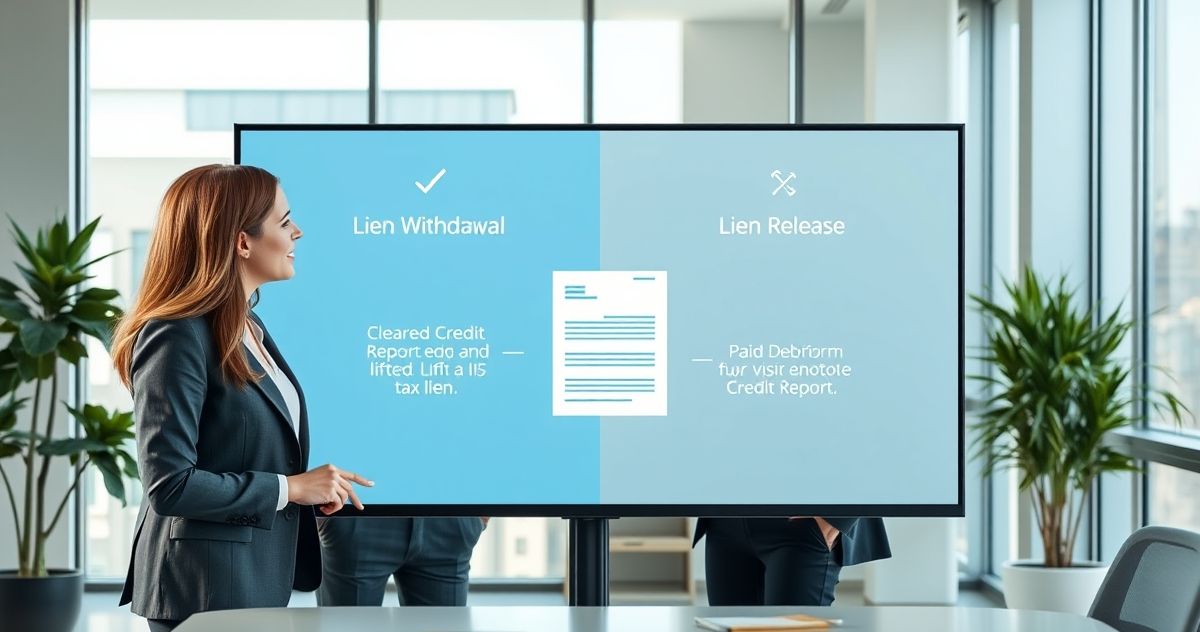When you owe back taxes, the Internal Revenue Service (IRS) may file a federal tax lien — a legal claim against your property, such as your home, car, or bank accounts, to secure payment of the tax debt. Understanding how liens are removed is critical for managing your credit and financial health. The two main IRS actions that remove liens are lien withdrawal and lien release, and they have significantly different effects.
What is a Tax Lien?
An IRS tax lien is a public record indicating the government’s claim to your assets because of unpaid taxes. It does not mean immediate seizure but serves as a notice to creditors and potential buyers that the IRS has a legal right to your property if the debt remains unpaid.
What is a Lien Withdrawal?
Lien withdrawal is the IRS’s process of removing the lien from your credit reports and public records as if the lien was never filed. This is important because it eliminates the negative credit impact and clears the public record, allowing better access to loans and credit.
When Can You Qualify for a Lien Withdrawal?
- You fully pay your tax debt before the lien is filed.
- You enter a direct debit installment agreement with the IRS and stay compliant for at least three consecutive months.
- The lien was filed in error or the taxpayer is innocent of the assessed tax.
A lien withdrawal requires submitting IRS Form 12277, “Application for Withdrawal of Filed Form 668(Y), Notice of Federal Tax Lien,” and meeting strict IRS criteria.
What is a Lien Release?
A lien release means the IRS officially ends its legal claim to your property, usually after you pay your tax debt in full or when the debt becomes unenforceable (typically after ten years from the assessment date). The lien release removes the IRS’s claim but does not immediately clear the lien from your credit reports.
The lien will generally remain visible on your credit report for up to seven years from the date the lien was originally filed. This is why a lien release does not improve your credit score immediately, but it serves as proof that the debt is resolved.
Practical Example
Suppose you owe $5,000 in back taxes. If you pay it quickly, perhaps before a lien is filed, or soon after filing, and meet other IRS conditions, you may qualify for lien withdrawal, which completely removes the lien as if it never happened. This can help restore your credit more swiftly.
If you pay off the taxes after the lien has been filed and withdrawal is not available, the IRS will issue a lien release. The lien no longer files a claim on your property, but the record of the lien will stay on your credit report and public records for several years.
Who Benefits From Each?
- Lien Withdrawal: Taxpayers who pay debts quickly, establish direct debit plans, or have erroneous liens benefit most, as withdrawal clears credit records.
- Lien Release: All taxpayers who pay their debts or wait out lien expiration receive a release, ending the IRS claim but keeping public records intact temporarily.
Tips for Managing Tax Liens
- Act promptly on tax debts to maximize chances for lien withdrawal.
- Set up a direct debit installment agreement and maintain payment compliance.
- If you believe a lien was filed incorrectly, request a withdrawal and provide supporting documentation.
- After lien release, regularly check credit reports for outdated lien information and dispute inaccuracies with credit bureaus.
- Consult a tax professional or use IRS resources to understand your rights and eligibility for lien removal.
Common Misconceptions About IRS Tax Liens
| Misconception | Reality |
|---|---|
| Lien release instantly removes the lien from credit reports. | The lien remains on credit reports for up to seven years after release; only withdrawal removes it immediately. |
| A lien means the IRS has taken your property. | A lien is a legal claim; the IRS must follow legal procedures to seize assets, which is separate from placing a lien. |
| Waiting to address a lien has no consequences. | Delay worsens credit damage as liens remain public records. Acting swiftly allows better options like withdrawal. |
Frequently Asked Questions (FAQ)
Q: Can I request a lien withdrawal myself?
A: Yes, by filing Form 12277 with the IRS. However, strict criteria must be met to qualify.
Q: How long after payment does the IRS issue a lien release?
A: Usually within 30 days after the IRS processes the full payment.
Q: Does a lien release improve my credit score immediately?
A: No. The lien remains visible on credit reports for up to seven years after release.
Q: Are lien withdrawals common?
A: They are less frequent than releases but can significantly benefit eligible taxpayers.
For more detailed information, see FinHelp’s articles on Lien Withdrawal and Tax Lien Release.
References
- IRS, “Understanding Tax Liens,” https://www.irs.gov/businesses/small-businesses-self-employed/tax-lien-withdrawals
- IRS Form 12277, “Application for Withdrawal of Filed Form 668(Y)” https://www.irs.gov/forms-pubs/about-form-12277
- Consumer Financial Protection Bureau, “How Tax Liens Affect Your Credit” https://www.consumerfinance.gov/ask-cfpb/what-is-a-tax-lien-en-1787/
- Investopedia, “What Is a Tax Lien?” https://www.investopedia.com/terms/t/taxlien.asp



